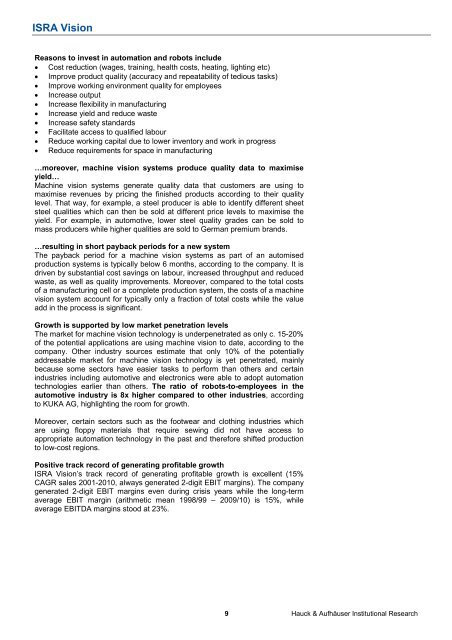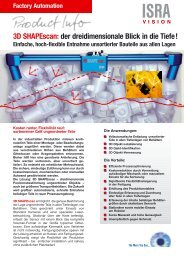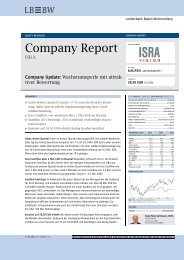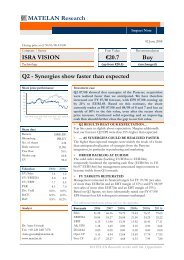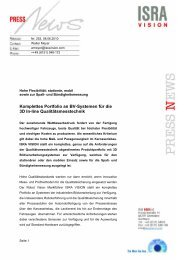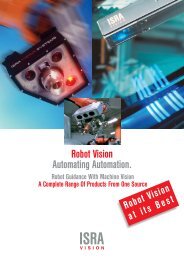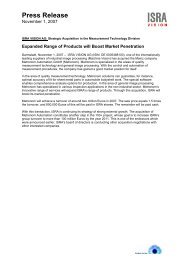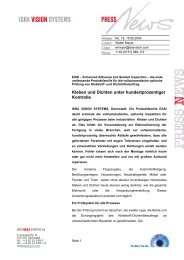Template for HA Research Notes - ISRA VISION AG
Template for HA Research Notes - ISRA VISION AG
Template for HA Research Notes - ISRA VISION AG
You also want an ePaper? Increase the reach of your titles
YUMPU automatically turns print PDFs into web optimized ePapers that Google loves.
<strong>ISRA</strong> Vision<br />
Reasons to invest in automation and robots include<br />
• Cost reduction (wages, training, health costs, heating, lighting etc)<br />
• Improve product quality (accuracy and repeatability of tedious tasks)<br />
• Improve working environment quality <strong>for</strong> employees<br />
• Increase output<br />
• Increase flexibility in manufacturing<br />
• Increase yield and reduce waste<br />
• Increase safety standards<br />
• Facilitate access to qualified labour<br />
• Reduce working capital due to lower inventory and work in progress<br />
• Reduce requirements <strong>for</strong> space in manufacturing<br />
Mmoreover, machine vision systems produce quality data to maximise<br />
yieldM<br />
Machine vision systems generate quality data that customers are using to<br />
maximise revenues by pricing the finished products according to their quality<br />
level. That way, <strong>for</strong> example, a steel producer is able to identify different sheet<br />
steel qualities which can then be sold at different price levels to maximise the<br />
yield. For example, in automotive, lower steel quality grades can be sold to<br />
mass producers while higher qualities are sold to German premium brands.<br />
Mresulting in short payback periods <strong>for</strong> a new system<br />
The payback period <strong>for</strong> a machine vision systems as part of an automised<br />
production systems is typically below 6 months, according to the company. It is<br />
driven by substantial cost savings on labour, increased throughput and reduced<br />
waste, as well as quality improvements. Moreover, compared to the total costs<br />
of a manufacturing cell or a complete production system, the costs of a machine<br />
vision system account <strong>for</strong> typically only a fraction of total costs while the value<br />
add in the process is significant.<br />
Growth is supported by low market penetration levels<br />
The market <strong>for</strong> machine vision technology is underpenetrated as only c. 15-20%<br />
of the potential applications are using machine vision to date, according to the<br />
company. Other industry sources estimate that only 10% of the potentially<br />
addressable market <strong>for</strong> machine vision technology is yet penetrated, mainly<br />
because some sectors have easier tasks to per<strong>for</strong>m than others and certain<br />
industries including automotive and electronics were able to adopt automation<br />
technologies earlier than others. The ratio of robots-to-employees in the<br />
automotive industry is 8x higher compared to other industries, according<br />
to KUKA <strong>AG</strong>, highlighting the room <strong>for</strong> growth.<br />
Moreover, certain sectors such as the footwear and clothing industries which<br />
are using floppy materials that require sewing did not have access to<br />
appropriate automation technology in the past and there<strong>for</strong>e shifted production<br />
to low-cost regions.<br />
Positive track record of generating profitable growth<br />
<strong>ISRA</strong> Vision’s track record of generating profitable growth is excellent (15%<br />
C<strong>AG</strong>R sales 2001-2010, always generated 2-digit EBIT margins). The company<br />
generated 2-digit EBIT margins even during crisis years while the long-term<br />
average EBIT margin (arithmetic mean 1998/99 – 2009/10) is 15%, while<br />
average EBITDA margins stood at 23%.<br />
9 Hauck & Aufhäuser Institutional <strong>Research</strong>


